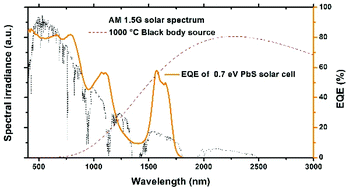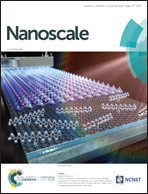Solution processed infrared- and thermo-photovoltaics based on 0.7 eV bandgap PbS colloidal quantum dots†
Abstract
Harnessing low energy photons is of paramount importance for multi-junction high efficiency solar cells as well as for thermo-photovoltaic applications. However, semiconductor absorbers with the bandgap lower than 0.8 eV have been limited to III–V (InGaAs) or IV (Ge) semiconductors that are characterized by high manufacturing costs and complicated lattice matching requirements in their growth and integration with higher bandgap cells. Here, we have developed solution processed low bandgap photovoltaic devices based on PbS colloidal quantum dots (CQDs) with a bandgap of 0.7 eV suited for both thermo-photovoltaics and low energy solar photon harvesting. By matching the spectral response of those cells to that of the infrared solar spectrum, we report a record high short circuit current (JSC) of 37 mA cm−2 under the full solar spectrum and 5.5 mA cm−2 when placed at the back of a silicon wafer resulting in power conversion efficiencies (PCEs) of 6.4% and 0.7%, respectively. Moreover, the device reached an above bandgap PCE of ∼6% as a thermo-photovoltaic cell recorded under a 1000 °C blackbody radiator.



 Please wait while we load your content...
Please wait while we load your content...